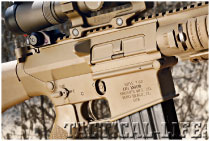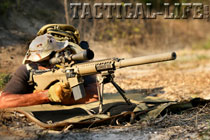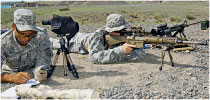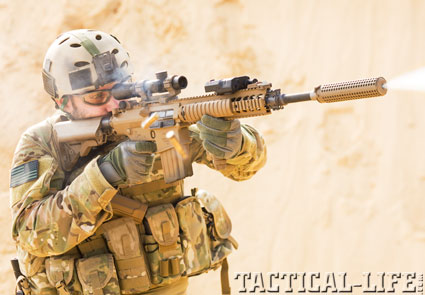“One shot, one kill.” This phrase is one that typically conjures images of America’s sniper elite. The next likely image that comes to mind is a scoped bolt-action rifle. The U.S. Army may be changing the familiar paradigm by fielding their new Knight’s Armament M110 semi-automatic, suppressed sniper rifle.
For a century, snipers have been regarded as “man hunters,” stalking high-valued military targets and obtaining intel from a concealed position in enemy territory. The sniper’s mission has been shifting since the end of the Vietnam War. Modern warfare and tactics have complicated the sniper’s traditional role, challenging their craft with multiple engagements from less than ideal locations on a dynamic battleground. The U.S. Army’s PEO (Program Executive Office) Soldier recognized this and has embarked on a search for a rifle that could best adapt to the War on Terror. After extensive testing, PEO teamed up with KAC (Knight’s Armament Company) to rapidly develop what many are calling the M24’s replacement.
“The Army came out with a requirement for a rifle that they wanted that would be a semi-automatic [firing] as accurate as possible,” says C. Reed Knight, owner of KAC. Knight was given a list of requirements that the SASS (Semi-Automatic Sniper System) had to meet, specifically:
Advertisement — Continue Reading Below
* Weigh less than 15 pounds
* Feature an integral silencer
* Include an adjustable stock
* Contain ambidextrous controls
* Include a bipod
On September 28, 2005, the U.S. Army awarded KAC the honor of producing the XM110 SASS and by April of 2007 soldiers in Afghanistan assigned to Task Force Fury became the first in a combat zone to receive the M110.
 Gun Details
Gun Details
Formerly known as the XM110, the “X” was dropped when the Army obtained field positive reports and considered the experiment complete. The M110 is based on KAC’s combat proven SR-25 (and similar to the USMC’s Mk 11 Mod 0) which, in turn, is loosely based on Eugene Stoner’s AR-10. The M110 features many refinements over its kin aimed at maximizing parts commonality with the standard-issue M16 and M4 service rifles, improved reliability and increased accuracy.
Advertisement — Continue Reading Below
The differences between the Army’s M110 and the Marine’s Mk 11 are in the details. The forend rail system on the Mk 11 is the KAC free-floated RAS while the M110 uses a URX modular rails system with folding front back-up iron sights (BUIS). Like the Mk 11, the buttstock is fixed but an adjustable buttplate gives the user the ability to set the length of pull. The adjustment can be made without tools by rotating a hand-tightened knob on the right side of the stock. On both sides of the stock are integral quick-detachable sling swivel sockets positioned near the lower receiver. The changes made to the stock, the addition of a two-sided (ambi) bolt catch, and a locking button on the folding front sight were the only improvements made to the XM110 in its transition to become the M110.
On top of the upper is the familiar M1913 Picatinny rail system. Issued with the rifle is a Leupold scope, set in a one-piece mount featuring integral 30mm rings. The complete system includes the Leupold 3.5 to 10 variable-power scope, a Harris bipod, an AN/PVS-14 night vision sight, and a Leupold tactical spotting scope. On the lower receiver are ambidextrous controls including the magazine release, safety selector and bolt catch for more universal operation.
The system was optimized for the M118LR cartridge but it has been tested effectively with dual-purpose anti-personnel/armor piercing ammunition with sub-MOA accuracy. Military.com’s Christian Lowe participated in a rare opportunity to test fire the M110 at U.S. Army’s Aberdeen Proving Grounds. “Plinking targets at 250 yards with the suppressed M110 was a breeze—especially with the Leupold Mark 4 3.5-10x scope,” Lowe says. “The action was smooth, the report sounded like a BB gun and the system is totally stable and easy to use,” Lowe adds.
Advertisement — Continue Reading Below
Advantages of the SASS
The bolt action M24 is known for its reliability and incredible accuracy. Its drawback lies in the area of rapid reloads, a feature becoming more important in the heavy insurgent environment. The M110 provides the sniper with as many as five well-aimed shots in five seconds, half the time it takes the same individual to operate the bolt action M24.
“It’s a very target-rich environment for them over there,” says Maj. Marc Meeker, assistant product manager for PEO. The most obvious advantage in the M110 deals with the magazine capacity, a drawback of the M24 identified by the subsequent M24A2, which features a 10-round detachable magazine. The M110, however, comes with 20-round magazines that can be quickly reloaded. This aspect of the M110 serves the demands of the PEO program that wants “something faster but just as lethal.”
In an ambush, the magazine fed M110 is superior to the bolt action where a spotter has to fight off attackers with his M4 as the sniper reloads loose rounds into the M24. “Operational testing showed that the SASS provides a 50 percent improvement in a sniper’s rate of engagement versus the M24 at distances up to and including the 800-meter mark,” reports Joshua Semick, lead engineer for the M110.
Advertisement — Continue Reading Below
 Besides saving the spotter’s hearing, the requirement for a suppressor was a tactical choice. The SASS concept flies in the face of an important aspect of the sniper’s craft… concealment. Having access to 20 shots suggest that a sniper might use them and, after firing more than two or three, a sniper’s hide has likely been compromised. The KAC suppressor reduces the audible sound signature and visible flash, thereby offering the team added protection.
Besides saving the spotter’s hearing, the requirement for a suppressor was a tactical choice. The SASS concept flies in the face of an important aspect of the sniper’s craft… concealment. Having access to 20 shots suggest that a sniper might use them and, after firing more than two or three, a sniper’s hide has likely been compromised. The KAC suppressor reduces the audible sound signature and visible flash, thereby offering the team added protection.
A 7.62 NATO bullet leaves the muzzle faster than the speed of sound, creating a small sonic boom that dissipates over distance as the bullet slows to a sub-sonic speed. It’s estimated that beyond 600 meters, a sniper can shoot and appear silent to the target. In urban areas where sound bounces off walls, the KAC suppressor assists with a sniper’s concealment by confusing the source of the shots. If a sniper takes his shot at 800 meters or beyond, he could make multiple anti-personnel shots without the enemy even being aware.
“I know from experience that snipers in Iraq love the M110, especially with its increased capacity and resemblance to the M16 which keeps you from silhouetting yourself as a ‘one-shot-one-killer,’” says Military.com’s Christian Lowe. “Now, I’ve heard rumors from the Marines that they were unimpressed with the weapon’s reliability in Iraq. But the soldier I talked to at Aberdeen said he’s been testing the heck out of the rifle and only saw minimal bolt cracking after nearly 15,000 rounds. The M24 is said to have a bolt lifespan of 5,000 rounds before a major reworking. While he recognized bolt-action purists would be horrified by the sacrilege of moving to a semi-auto system, he said with the number of targets typically being engaged by snipers in the war zone, he’d rather have 20 rounds per magazine than six any day of the week. ‘With this I get 20 rounds and a split second between shots,’ he said. ‘I can kill more targets every time with this.’”
Advertisement — Continue Reading Below
Joining the Ranks
Being that the KAC SR-25, the M110’s close relative, has served special ops units like the U.S. Navy SEALs exceptionally well, the Army has chosen to move past debate and quickly enlist the most comprehensive solution snipers have seen in decades. Thus far, the M110 has proven itself effective against enemy personnel and light materiel targets out to 1,000 meters. Achieving success in the War on Terror requires getting essential capabilities to where they’re needed as quickly as possible. The M110 resulted from the PEO program that identifies and adapts existing technologies in three years or less. The M110 serves as an example of an improvement over the normal seven-to-10 year acquisition timeline.
 The first soldiers to receive the M110 were snipers from the 4th Brigade, 10th Mountain Division who obtained their rifles in time to train before deploying with them. “Our focus is to try to get this weapon to units prior to their deployment,” says Maj. Meeker. “We don’t want to field it to them in theater. We would rather train them here on the ground in a peacetime environment, and then have them outfitted with the best and newest equipment as they go forward on the battlefield,” he adds.
The first soldiers to receive the M110 were snipers from the 4th Brigade, 10th Mountain Division who obtained their rifles in time to train before deploying with them. “Our focus is to try to get this weapon to units prior to their deployment,” says Maj. Meeker. “We don’t want to field it to them in theater. We would rather train them here on the ground in a peacetime environment, and then have them outfitted with the best and newest equipment as they go forward on the battlefield,” he adds.
“It’s everything a sniper wants,” says Sgt. Jed Christianson after training with the M110. “We’re all very excited about this new weapon system because it’s custom-tailored to the kind of fight we’re in, in Iraq.”
Advertisement — Continue Reading Below
The U.S. Army plans to field nearly 3,000 M110s with many rifles already serving overseas but the adoption of the M110 hasn’t come without great debate. Much praise has been said for the Army’s move to keep the 7.62 NATO chambering. Some argue against Stoner’s AR design entirely. For those partial to the bolt action, know that the U.S. Army still plans on acquiring M24s through February 2010.
 BulletFlight: Ballistic Data For The iPOD
BulletFlight: Ballistic Data For The iPOD
Knight’s Armament now offers portable ballistics software for the iPhone and iPod Touch and is developing a water-proof rail mount. A bullet’s impact becomes more predictable with accurate calculations that factor in environmental details (i.e., distance, wind direction, temperature, elevation). The software can even automatically get weather data from your current location. The display gives you the information you need for the current shot rather than showing a complex table. BulletFlight, available for purchase by anyone directly from the ‘App Store’ comes pre-loaded with several rifle profiles, but you can easily add more—not just for the M110, but any rifle. For more information visit www.knightarmco.com.
Interested in more new technology? Check out this article about The Tactical Smartwatch Built Tough For Any Mission!
Advertisement — Continue Reading Below























